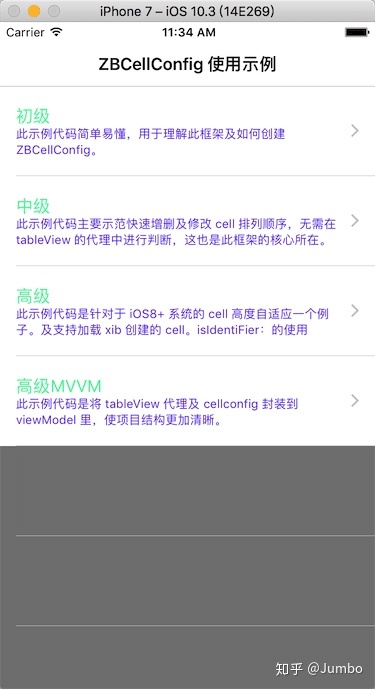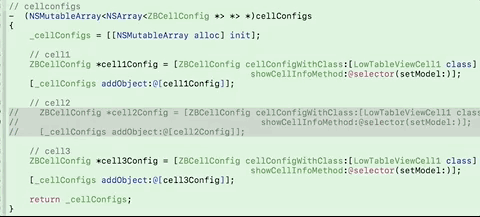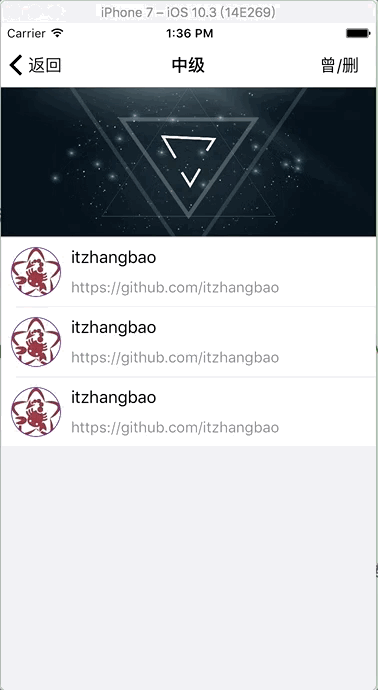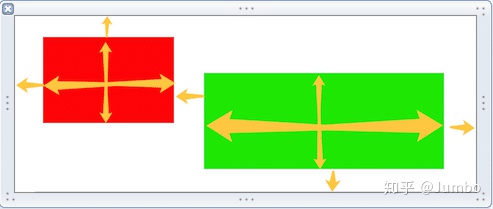
前言
当一个 tableView 中的 cell 类型过多时,我们务必会在 tableView 的各个代理中做这样那样的判断,当需要增加一种 cell,或调换 cell 的顺序的时候我们就会在 tableView 的各个代理中进行修改判断。 使用 ZBCellConfig 可以应对各种变态需求,当增删、调换 cell 的顺序时,只需一键配置。
简介
- ZBCellConfig 对象实例会将 tableView 中 cell 所需的基本信息存储下来,然后放到数组中进行管理;
- 每个 ZBCellConfig 实例与 tableView 中想要显示的 cell 相对应。(但注意,是"想要显示的"cell,由于 cell 的重用,实际上 cell 并不会生成那么多);
- 优点:改变不同类型 cell 的顺序、增删时,极为方便,只需改变用于存放 ZBCellConfig 的数组即可,** 重点是无需在多个 tableView 代理方法中逐个修改 **。
结构

使用
- 支持 cocoapods 导入
pod 'ZBCellConfig' - 直接将文件拖拽到项目中
#import "ZBCellConfig.h"
知识点
请下载示例项目查看详细使用方法及实际中如何使用 GitHub 下载地址。 初、中、高、高 MVVM 内容上是一样的,区别在于没一级别知识点递增。

基本使用
1 . 首先在控制器中声明存放 ZBCellConfig 实例的二维数组
/**
* 二维数组 (匹配 tableView 的数据结构,第一层是 section,第二层放 cell)
*/
@property (nonatomic, strong) NSMutableArray <NSArray <ZBCellConfig *> *> * cellConfigs;
2-1 . 初始化数组,每一个 ZBCellConfig 为 cell 的基本信息,改变不同类型 cell 的顺序、增删时,只需在此修改即可,无需在多个 tableView 代理方法中逐个修改(具体查看 Demo 注释很清晰)
- (NSMutableArray<NSArray<ZBCellConfig *> *> *)cellConfigs {
_cellConfigs = [[NSMutableArray alloc] init];
// cell1
ZBCellConfig *cell1Config = [ZBCellConfig cellConfigWithClass:[LowTableViewCell1 class] showCellInfoMethod:@selector(setModel:)];
[_cellConfigs addObject:@[cell1Config]];
// cell2
ZBCellConfig *cell2Config = [ZBCellConfig cellConfigWithClass:[LowTableViewCell1 class] showCellInfoMethod:@selector(setModel:)];
[_cellConfigs addObject:@[cell2Config]];
// cell3
....
return _cellConfigs;
}2-2 . 增删只需这样:


3 . tableView 代理中实现部分
- (NSInteger)numberOfSectionsInTableView:(UITableView *)tableView
{
return self.cellConfigs.count;
}
- (NSInteger)tableView:(UITableView *)tableView numberOfRowsInSection:(NSInteger)section
{
return [self.cellConfigs[section] count];
}
- (UITableViewCell *)tableView:(UITableView *)tableView cellForRowAtIndexPath:(NSIndexPath *)indexPath
{
// 根据 indexPath 获取 对应的 cellConfig
ZBCellConfig *cellConfig = self.cellConfigs[indexPath.section][indexPath.row];
// 根据对应的 cellConfig 获取 cell,并给 cell 赋值 根据模型显示。
// • dataModels: 这里由于为示例代码不是用真实数据,只起到 执行 cell 的赋值函数。在实际项目中应该传递从网络请求的真实数据。
UITableViewCell *cell = [cellConfig cellOfCellConfigWithTableView:tableView dataModels:@[[LowModel new]]];
return cell;
}
cell 自适应高度
1 . tableView 设置如下
/**
* default is 0, which means there is no estimate
* estimatedRowHeight 默认为 0,不估算cell高度
* 赋值不为 0 时候,开启cell估值配合 layout 约束,进行cell高度自适应
* 也就是说想要自动布局 cell 高度就给这个 estimatedRowHeight 属性赋值,值为你所有 cell 的平均高度的一个估值
*/
_heightTableView.estimatedRowHeight = 100;
// iOS8 系统中 rowHeight 的默认值已经设置成了 UITableViewAutomaticDimension
_heightTableView.rowHeight = UITableViewAutomaticDimension;
2 . cell 需采用 AutoLayout 布局,masory 或 xib 托线的形式皆可,约束规定上左下右还有让 cell 知道内容的高:

tableView style
- UITableViewStylePlain 和 UITableViewStyleGrouped 区别
- UITableViewStylePlain:sectionView 当 tableView cectionHeader/Footer 会默认高度为 0, 滑动到顶部时 会停留到导航栏底部
- UITableViewStyleGrouped:sectionView 当 tableView cectionHeader/Footer 会默认高度为 10, 滑动到顶部时 不会停留到导航栏底部
- 注意:当需要 为 UITableViewStyleGrouped 时查看【MediaExample 使用示例】
ZBCellConfig
通过函数 - (void)zb_performSelector:(SEL)aSelector withObjects:(NSArray *)objects来执行 初始化时配置好的showCellInfoMethod。 此函数是对 - (id)performSelector:(SEL)aSelector withObject:(id)object1 withObject:(id)object2;的一个扩展,以数组的形式来传递多参数。 函数实现部分:
// 签名
NSMethodSignature *signature = [[self class] instanceMethodSignatureForSelector:aSelector];
if (signature == nil) {
NSAssert(false, @"LINE=%d ERROR - 找不到 %@ 方法", __LINE__ ,NSStringFromSelector(aSelector));
}
// 包装
NSInvocation *invocation = [NSInvocation invocationWithMethodSignature:signature];
// 设置调用者
[invocation setTarget:self];
// 设置调用的方法 与 NSMethodSignature 签名的方法一致
[invocation setSelector:aSelector];
// 0为target 1为_cmd 所以从2索引
for (int i = 0; i < (signature.numberOfArguments - 2); i++) {
id dataModel = i < objects.count ? objects[i] : nil;
[invocation setArgument:&dataModel atIndex:i+2];
}
// retain 所有参数,防止释放
[invocation retainArguments];
[invocation invoke];总结
把将要展示的几种 cell 的基本信息 以 tableView 的数据结构二维数组的形式存放,储存基本配置并不会生成多余的 cell,内部创建采用 tableView 的重用机制。示例 Demo 中注释详细,itzhangbao/ZBCellConfiggithub.com

If I have no knife,I can't protect you.If I had a sword,I can't hold you. 如果我没有刀,我就不能保护你。如果我有刀,我就不能拥抱你。 ————《剪刀手爱德华》



















 3845
3845











 被折叠的 条评论
为什么被折叠?
被折叠的 条评论
为什么被折叠?








